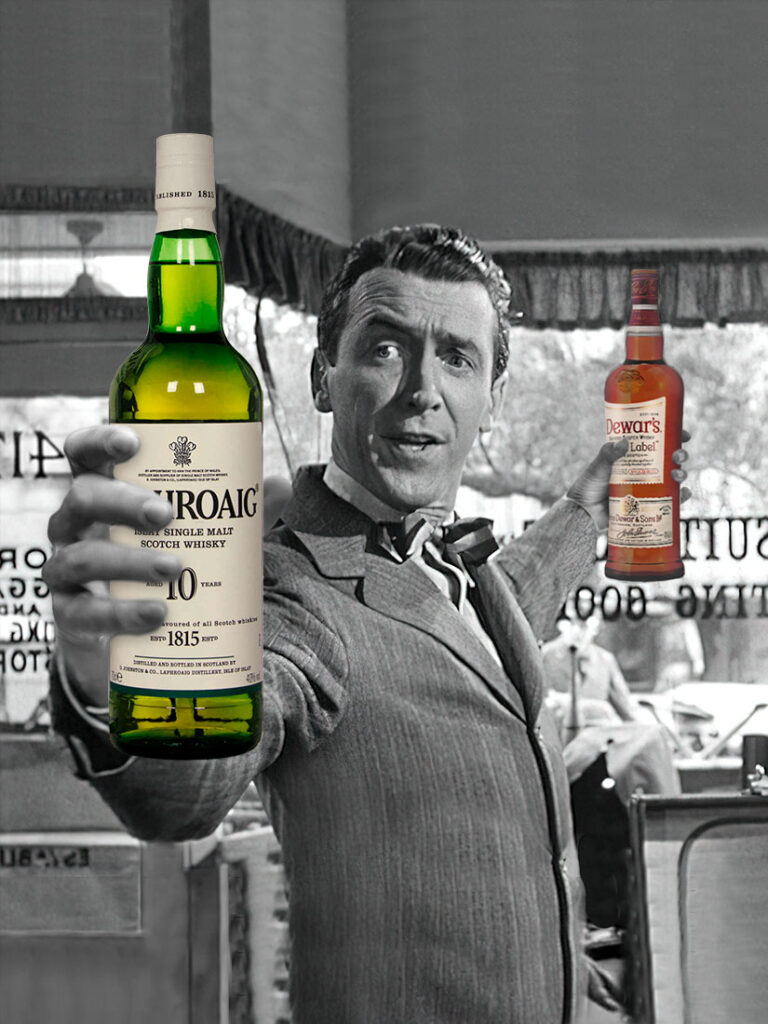The Second Bite
It was my college roommate Krishna who first introduced me to the miraculous liquid known as scotch, but it was my friend Brad who, a few years later, opened the door to the diverse world of single-malt scotch by offering me my first taste of Laphroaig.
Laphroaig, for the uninitiated, tastes like dirt. There’s a story that during Prohibition, wholesalers were still able to import Laphroaig by having the distillery ship it in containers marked “cleaning fluid.” Supposedly the customs inspector who sampled it concluded that no human being would ever drink this stuff, so he let it go through.
Single-malt whiskies such as Laphroaig are made at a single distillery using local ingredients. As a result, each single malt has its own unique character that can’t be duplicated elsewhere. The most familiar brands of scotch, such as Johnnie Walker or Dewars, are blended whiskies whose distillers mix together a variety of single malts to create a product that’s smooth and inoffensive. Single malts, unlike blends, are willing to offend. Laphroaig, for example, is noted for its overpowering flavors of smoke and peat, which some people despise and others (like me) relish.
But “relish” is not a word that I’d use to describe my first sip of Laphroaig. It tasted so unlike the blended whiskies I was accustomed to that I thought that the bartender had made a mistake. I imagined that he must accidentally have poured a shot of — well, cleaning fluid. If not for the potential embarrassment of doing so in the classy New York bar that Brad had led me into, I probably would have wanted to spit it out.
Then a remarkable thing happened when I took my second sip. Now that I’d been forced to abandon my expectations, and to realize that my previous experiences of drinking scotch were irrelevant, I was able to experience the whisky on its own terms. “Oh!” I remember thinking. “I get it now!”
That incident led to my formulating a theory that I call “the second bite.” The first bite (or sip, or revelation) of something new is about the shock of experiencing something unexpected, of having one’s preconceptions violated. That experience says more about the taster than the thing being tasted. It’s only on the second bite that one can start to appreciate the thing for what it actually is.
Although the second-bite principle applies primarily to food or drink, it’s not exclusive to comestibles. It explains, for example, why I have such an ambivalent reaction to the movie “It’s a Wonderful Life,” which so many people love unreservedly. In the unlikely event that you haven’t seen the film, its protagonist, George Bailey — played by Jimmy Stewart — is in despair, beset by problems beyond his control, and is about to take his own life. An apprentice angel, Clarence, intercedes and takes George on a tour of his hometown, showing how worse off the town would have turned out if George had never been born.
The people he encounters don’t recognize George (since, from their point of view, he’d never existed), and he reacts in the way you undoubtedly would if someone with whom you’d been intimate suddenly treated you as a stranger — with shock and distress. But that’s just the first bite: his surprise and confusion in response to an experience he was not prepared for.
In each situation, he is eventually able to take the second bite, observing the state of affairs that his nonexistence has brought about. He sees that Mr. Gower, the respected pharmacist for whom he had worked in his youth, is now a drunken ex-convict who has served time for a child’s death as a result of his dispensing the wrong medication — an error that George, in real life, had prevented. He discovers that his brother Harry, who should have gone on to become a war hero, instead died at age nine in a drowning accident that George, in real life, had saved him from. These and a series of similar incidents are quite moving, and prompt us to reflect on the ways that our own existence might have improved the world in ways we’re unaware of.
But each time, before we get to the interesting part — the lesson learned — we have to sit through the first bite: “Don’t you know me? I’m your friend/neighbor/son/husband…!” followed by George’s anguish at not being recognized. I find myself getting increasingly impatient, which is difficult when the object of one’s impatience is someone as likeable as Jimmy Stewart. “Come on, George,” I want to say. “We get it by now — you’ve never been born. Why can’t you get it?”
All too often, as Frank Capra did in directing “It’s a Wonderful Life,” we concentrate too much on the first bite, which has nothing new to tell us. All first bites are the same. But every second bite is different, and those are the ones we should be paying attention to.

I was wondering how the inspector during Prohibition “sampled” cleaning fluid. It seems to me if they did that there would have been even more deaths than the ones that George prevented by his existence.
I’ve actually wondered the same thing, but I’d rather put that question aside than ruin a good story!